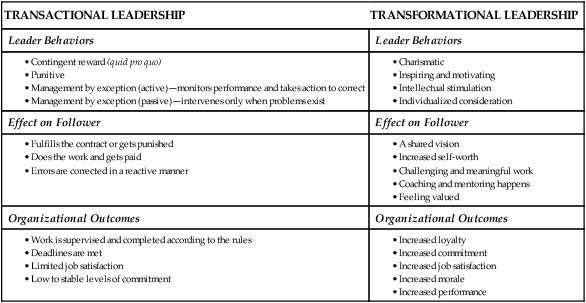• Analyze the role of leadership in creating a satisfying working environment for nurses. • Evaluate transactional and transformational leadership techniques for effectiveness and potential for positive outcomes. • Value the leadership challenges in dealing with generational differences. • Compare and contrast leadership and management roles and responsibilities. • Describe leadership development strategies and how they can promote leadership skills acquisition. • Analyze leadership opportunities and responsibilities in a variety of venues. • Explore strategies for making the leadership opportunity positive for both the leader and the followers. A leader is an individual who works with others to develop a clear vision of the preferred future and to make that vision happen. Oakley and Krug (1994) call that type of leadership enlightened leadership, or the ability to elicit a vision from people and to inspire and empower those people to do what it takes to bring the vision into reality. Leaders bring out the best in people. Atchison (2004) asserts that leaders have followers. An individual can have an impressive title, but that title does not make that person a leader. No matter what the person with that title does, he or she can never be successful without having the ability to inspire others to follow. The leader must be able to inspire the commitment of followers. Covey (1992) identifies eight characteristics of effective leaders (Box 3-1). Effective leaders are continually engaging themselves in lifelong learning. They are service-oriented and concerned with the common good. They radiate positive energy. For people to be inspired and motivated, they must have a positive leader. Effective leaders believe in other people. They lead balanced lives and see life as an adventure. Effective leaders are synergistic; that is, they see things as greater than the sum of the parts and they engage themselves in self-renewal. Healthcare organizations are complex. In fact, health care is complex. Continual learning is essential to stay abreast of new knowledge, to keep the organization moving forward, and to continue delivering the best possible care. There is an emphasis on organizations becoming learning organizations, providing opportunities and incentives for individuals and groups of individuals to learn continuously over time. A learning organization is one that is continually expanding its capacity to create its future (Senge, 2006). Leaders are responsible for building organizations in which people continually expand their ability to understand complexity and to clarify and improve a shared vision of the future—“that is, they are responsible for learning” (Senge, 2006, p. 340). Management and leadership are both important in the healthcare environment. The problem facing healthcare organizations is that they are overmanaged and underled (Atchison, 1990). We can teach new managers, but our leaders are developed over time and through experience. Thus it is important that we value, support, and provide our leaders with the one thing vital for good leadership—good followership. Leadership is a social process involving leaders and followers interacting. Followers need three qualities from their leaders: direction, trust, and hope (Bennis, 2009). The trust is reciprocal. Leaders who trust their followers are, in turn, trusted by them. The manager is concerned with doing things correctly in the present. The role of manager is very important in work organizations because managers ensure that operations run smoothly and that well-developed formulas are applied to staffing situations, economic decisions, and other daily operations. The manager is not as concerned with developing creative solutions to problems as with using strategies to address today’s issues. Covey (1992) believes that a well-managed entity may be proceeding correctly but, without leadership, may be proceeding in the wrong direction. An analysis of several dozen interviews of healthcare workers (including physicians), when asked what followers desire from leaders, produced the following responses in rank order (Atchison, 2004): 2. Control of the decisions that most affect me 4. Balance of life—colleagues and family, job and home, work and play A transactional leader is the traditional “boss” image. In a transactional leadership environment, employees understand that a superior makes the decisions with little or no input from subordinates. Transactional leadership relies on the power of organizational position and formal authority to reward and punish performance. Followers are fairly secure about what will happen next and how to “play the game” to get where they want to be. A transactional leader uses a quid pro quo style to accomplish work (e.g., I’ll do x in exchange for your doing y). Transactional leaders reward employees for high performance and penalize them for poor performance. The leader motivates the self-interest of the employee by offering external rewards that generate conformity with expectations. The status quo is continually reinforced in organizations in which transactional leadership is practiced (Weston, 2008). Transformational leadership is based on an inspiring vision that changes the framework of the organization for employees. Employees are encouraged to transcend their own self-interest. This style of leadership involves communication that connects with employees’ ideals in a way that causes emotional engagement. The transformational leader can motivate employees by articulation of an inspirational vision; by encouragement of novel, innovative thinking; and by individualized consideration of each employee, accounting for individual needs and abilities. The result of such leadership is that both leaders and followers have a higher level of motivation and a greater sense of purpose (Weston, 2008). Covey (1992) states, “The goal of transformational leadership is to transform people and organizations in a literal sense, to change them in mind and heart; enlarge vision, insight, and understanding; clarify purposes; make behavior congruent with beliefs, principles, or values; and bring about changes that are permanent, self-perpetuating, and momentum-building” (p. 287). Kouzes and Posner (2007) identify five key practices in transformational leadership, as follows: 1. Challenging the process, which involves questioning the way things have been done in the past and thinking creatively about new solutions to old problems 2. Inspiring shared vision or bringing everyone together to move toward a goal that all accept as desirable and achievable 3. Enabling others to act, which includes empowering people to believe that their extra effort will have rewards and will make a difference 4. Modeling the way, meaning that the leader must take an active role in the work of change 5. Encouraging the heart by giving attention to those personal things that are important to people, such as saying “thank you” for a job well done and offering praise after a long day A transformative leader seems particularly suited to the nursing environment. There is additional evidence in the literature that transformational leadership produces very positive results in the workplace. Robbins and Davidhizar (2007) link transformational leadership qualities with staff satisfaction, staff retention, and patient satisfaction. Raup (2008) found that nurse managers with effective leadership skills are an essential component to addressing the nursing shortage because lower staff turnover resulted from transformational leadership, although no correlation existed between leadership style and patient satisfaction. Another study found that there was great benefit in spending resources to develop clinical leaders. After transformational leadership development, the nursing team derived benefit because the more effective leadership promoted effective communication, greater responsibility, empowerment, job clarity, continuity of care, and interdisciplinary collaboration (Dierckx de Casterle, Willemse, Verschueren, & Milisen, 2008). Another study found that a transformational leadership style was closely associated with followers’ working conditions, namely involvement, influence, and meaningfulness. This study also found a direct path between leadership behavior and employee well-being (Nielsen, Yarker, Brenner, Randall, & Borg, 2008). Marchionni and Ritchie (2008) found that the presence of a supportive culture in which learning is valued, coupled with transformational leadership, is a key factor in the implementation and sustainability of best practice guidelines. Positive outcomes are derived from effective leadership in organizations. Transformational leadership is hard work; investment of time and energy is required to bring out the best in people. Transformational leadership is not unique to nursing as the Research Perspective on p. 41 illustrates.
Developing the Role of Leader
What Is a leader?
Leadership as a Primary Determinant of Workplace Satisfaction
The Practice of Leadership
Leadership Approaches
Transactional Leadership
Transformational Leadership
Developing the Role of Leader
Get Clinical Tree app for offline access





